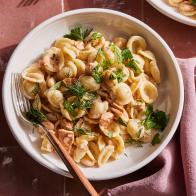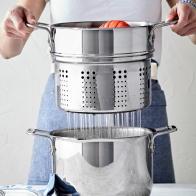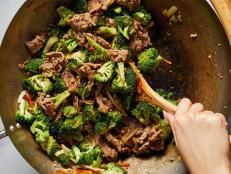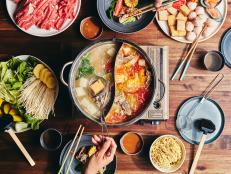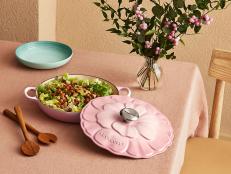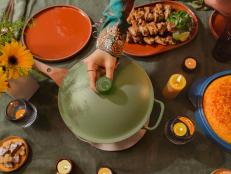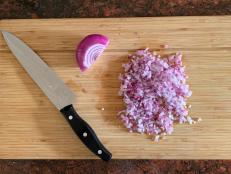How to Cook a Bunch of Little Dishes for a Crowd
Korean cuisine is known for its impressive spreads of banchan a.k.a. side dishes. Here are tips to pulling off your own well-balanced, ever-changing assortment.


Justin Ong/Getty
If I tried to make a list of all the unique banchan my mother, Moungsoon, has cooked for us over the past 30 years, I could write my own cookbook. She’s always had a knack for striking the perfect, balanced assortment and number of these tiny dishes, meant to accompany rice and mains at a Korean dinner table. The banchan would then revisit the table a few more times as we relished in the flavor, but would be gone just before we tired of them. It’s truly a feat whenever you see it, whether you’re invited into a Korean family home for dinner, or you sit down at a Korean restaurant and are presented with so many banchan they’re about to fall off the table (or are literally stacked on top of each other).
But how to manage making all these banchan, much less eating it? Here are a few tips and tricks from professional banchan makers (and my own mother):

Matt Armendariz
Keep It Balanced
When planning your banchans, it’s important to consider the spread as a whole. There are generally three main types of banchan – fresh vegetable banchan like namul or muchim; braised or soy sauce-based banchan called jorim; and well-preserved mit banchan like kimchi or jeotgal, that’s usually on hand in large batches. Ideally, you want to have coverage across the board.
Jihee Kim, chef of Perilla LA, a banchan popup that rotates its takeout menu weekly, makes sure to look at all her banchan items to maintain balance. “I can’t make everything be just vinegary or all spicy,” says Kim. She’ll check her flavor profiles, first choosing a plain namul, lightly seasoned with sesame oil, then something with doenjang (fermented soybean) like her pickled shishito and rounding it out with a fresh geotjeori kimchi that’s less vinegary. “This way, when people get one of everything, they’ll have the complete flavor palate,” says Kim.
My mother would additionally think about dishes that would be both healthy and appealing to her kids. “I thought about things that are nutritious and balanced, and would help you grow well,” she said. Choose a few vegetable-focused options, and then pair with a meat or fish banchan to balance it out.
Keep Your Go-To Banchans Well Stocked
When it comes to Korean cuisine, it’s important to always have your base-level banchan on hand. Known as mit banchan, these include the ever-present kimchi, as well as jeotgal (salted shellfish or seafood) and pickles. Before refrigerators became prevalent, kimjangs were held once a year, to make all the kimchi a family needed to last them through the winter. But nowadays, with Asian grocery stores making vegetables more readily available year-round, it’s easy to plan to make more kimchi just before your current stash is completely depleted. These mit banchan will also last a long time, so you can make plenty in advance.
Prepare One or Two Fresh Banchan Day Of
Once you have your basics down, focus on making a couple fresh banchan for the dinner table. This is a great opportunity to take advantage of seasonal offerings and add variety. This is especially important for Ji Young Kim of East Branch Farms, a New York-based farm and CSA that creates a weekly seasonal menu featuring their local organic produce. “I make our banchan with what’s fresh – broccoli, cauliflower, or baechu (cabbage),” says Kim. Cook and season these banchan lightly so the fresh flavors shine through.
Make Only as Much as You Can Eat
To ensure all your banchan is enjoyed at their peak, do some mental math to determine how much to make. Fresh vegetable banchan, like namul, should be made in very small quantities – just enough for your family or guests to consume the same day. But longer cooked and soy sauce-based banchan, like jorim or jjim, can be enjoyed for several days over multiple meals. My mother likes to make a large pot of her galbi jjim since it can last quite a while, and it’s a family favorite.
Get Creative with Your Leftovers
Just because a dish starts as banchan, doesn’t mean it has to stay banchan! These can be easily repurposed into classic Korean recipes like kimchi fried rice, bibimbap or kimbap. After frying up platters of jeon for a party, my mother uses up any large quantities of leftovers in a hearty stew, or jjigae, the next day.
Or think outside the Korean box – banchan doesn’t always have to be eaten with rice. “I often make scrambled eggs or spaghetti with namul,” says Jihee Kim. “My husband loves to eat banchan with fried chicken or steak,” she adds.

The Washington Post/Getty
A good banchan spread relies heavily on variety, which naturally plays well with different types of food. By balancing reliable stalwarts with fresh newcomers, banchan can keep a standard dinner spread interesting. As my mother says, “Banchan is the key to Korean food.”
Related Content:

